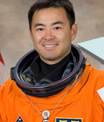Training for H-II Transfer Vehicle (HTV) and the Japanese Experiment Module (Kibo)
Astronauts Hoshide and Yamazaki temporarily came back to Tsukuba Space Center (TKSC) in Japan to participate in training sessions on the H-II Transfer Vehicle (HTV).
During the training sessions, they learned HTV equipment operations, HTV-related activities that crew members aboard the International Space Station (ISS) will perform, and emergency operations in case of anomaly.

Astronaut Yamazaki (left) reviewing the locations of system equipment in the Pressurized Module (PM)
Astronaut Yamazaki also participated in training sessions for the Japanese Experiment Module (JEM), Kibo, to maintain and improve her knowledge and skills in operating Kibo’s systems and robotic arm, the JEM Remote Manipulator System (JEMRMS). The sessions included reviews of the daily activities associated with Kibo’s system operations and the stowage locations of equipment in the Pressurized Module (PM), as well as operation training on the experiments and the High Definition Television (HDTV) transmitting system onboard Kibo.
Astronaut Hoshide meanwhile attended the Kibo-related training for STS-127 (2J/A) mission crew members.
He was present at the session to familiarize himself with the crew members’ activities during the STS-127 mission, as he is assigned as a Capsule Communicator (ISS CAPCOM). He will be in charge of communication between the ISS and NASA’s Mission Control Center during the STS-127 mission.

The STS-127 and the Expedition 20 Mission crew members participating in the operational training of Kibo’s robotic arm, the JEM Remote Manipulator System (JEMRMS)
Training for the STS-127 mission crew members focused on the operations of the JEMRMS. They practiced transfer operations for moving the Inter-orbit Communication System-Exposed Facility subsystem (ICS-EF) and the Monitor of All-sky X-ray Image (MAXI) from the Experiment Logistics Module-Exposed Section (ELM-ES) onto the Exposed Facility (EF) . This robotic transfer operation will be performed during the STS-127 mission.
In addition, they received training on how to operate the Exposed Facility Unit (EFU), the Payload Attachment Mechanism (PAM), and the Exposed Facility Berthing Mechanism (EFBM) from the System Laptop Terminal (SLT) in Kibo.
Astronaut Hoshide will support the STS-127 (2J/A) Mission as an ISS CAPCOM, communicating with the STS-127 Mission and the ISS crew members, including Astronaut Wakata.


